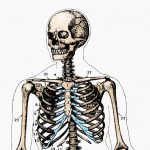Tags
Share This
Hungry

Crystal Renn gave me a lot of food for thought in her memoir, Hungry (written in collaboration with Marjorie Ingall).
Her struggle with anorexia and exercise bulimia, fueled by her modeling ambition, is painful to read. She subsists for years—tender teenage years—on undressed salad, plain steamed vegetables, sugarless gum, Diet Coke, and the occasional protein drink. (During those same years, Pizza Hut occupied all corners of my food pyramid.) She works out for up to eight hours a day. She joins two gyms, so people won’t suspect she has a problem. One glance at her 95-pound 5’9″ shadow of a body must have given that away. I’m not sure how her mom stood by and watched all this without scooping up the half of her daughter that remained and whisking her away from New York and all things fashion for a while! Instead Mother Nature stepped in. Renn’s body outsmarted her.
I agree with Renn’s theory: a body has a set point and will fight like hell to stay in its natural range. For me, that’s 125 to 135. I could stay around 127 as a model without resorting to anything more extreme than eating healthy food (a lot of it), exercising regularly (nothing obsessive), and not drinking too often (i.e. about three times a week—oh, those were the days). Bad luck for Renn that her set point is 30 pounds higher…or, as it turns out, good luck. Her story has a fairytale ending. But let me chew on some other thoughts first before getting to that.
Renn’s anorexia is not the average model’s story. And she is fair in not blaming the industry for her obsessive-compulsive approach to reaching for the supermodel brass ring. She did, however, open my eyes to how out of hand the skinny standard has gotten in the editorial world in the past decade. Renn makes the point that in the early 90s, Kate Moss seemed “shockingly skinny. Now Kate Moss-level skinny no longer seems novel. So the girls had to get skinnier.” Check out shots from any of the big shows, most editorials, high fashion ads, and you’ll see she’s right. These girls are sporting toothpick appendages. (Re. Renn’s claim that models are much taller now than several decades ago—I don’t get it. Lauren Hutton started modeling in the 50s and, at 5’7 1/2″, says she was always the shortest. See my “Lauren Hutton” interview.)
I asked my longtime modeling friend Audi Martel, fit model for Carolina Herrera and Zac Posen, about this weighty issue. “Yes, editorial models are way skinnier than they were a decade ago, and the most frustrating part is that clients won’t admit there’s anything wrong. ‘Oh, she eats,’ they’ll say, about a paper thin model they’ve booked. But I’ve been watching, and, no, she does not eat.”
Does this change my opinion where weight comes up elsewhere in my blog? (Note to self: write a blog that does not contain the word weight.) No, the bottom line is always the same. Don’t go leaning so far out, desperately grasping for that supermodel brass ring—you’re liable to land flat on your face (passed out on Madison Avenue if you’re as malnourished as Renn was). The skinny-mania is most rampant at the top. The catalog world, the smaller markets, less prestigious editorial, regional fashion shows—they accommodate models who don’t disappear when they turn sideways.
If you’re as lucky as Renn you’ll have the best of both worlds. After all those bland vegetables, torturous hours on treadmills and pacing hotel hallways, she gained back those 70 pounds…and her happiness andbecame a plus-size supermodel—something that didn’t exist when Kate Moss trudged onto the scene. Emaciated duckling turns plump swan—bravo!













Renn looks “super” – AND healthy in photo. It’s heartening to know that there’s hope for “normal” girls in modeling world.
This was a GREAT article to read! Having been an “international” model myself for 12 yrs, weight was ALWAYS a problem in the modeling industry. I was however one that never listened to the clients and my agents, I ate what I wanted and drank what I wanted (I was lucky to have the genes to do this until 30 hit me and then it was a huge struggle to keep a nice thin body!) and when I was bored and wanted to hang out with my other fellow models I went to the gym. I am sure this on some levels effected a few jobs but I still took in the bookings and probably might have taken in more IF I would have been less then my 125 pound body at 5’9 and a half. That sounds like a pretty nice and healthy body if you ask me (boy would I kill to have my old modeling body back after turning 41 and one child later!). After 12 yrs in the modeling industry I saw a few very very disturbing girls go through hell and back to have the perfect body and go to great length and starvation, throwing up to get it. They were such unhappy girls too, their every waking moment was food. I dont think the industry will EVER change, and as long as there are young girls starving to be SUPER MODELS there will be clients wanting to book these very thin girls. Its so sad!
wow, Crystal Renn looks STUNNING in that photo. curvy, smooth, beautiful!